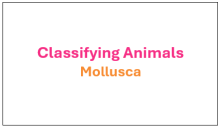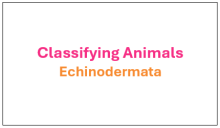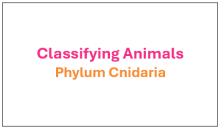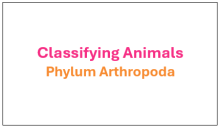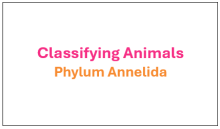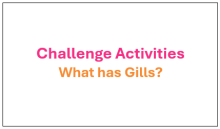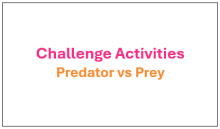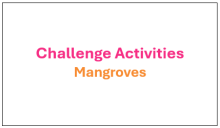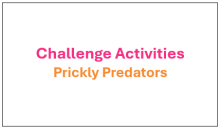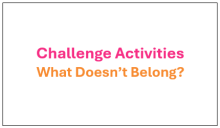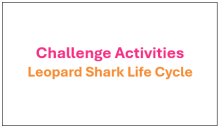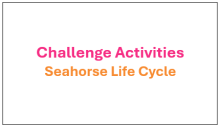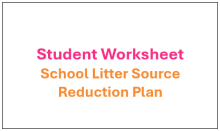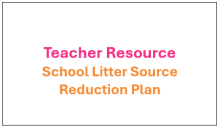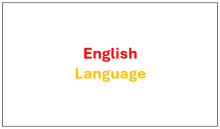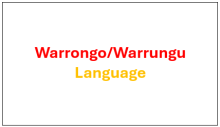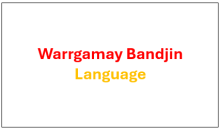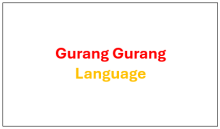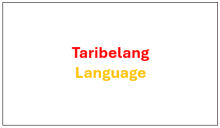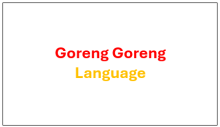- All pages
- Primary school
- Middle school
- Senior school
Middle/Senior Grade 7 to 11 - Mollusca
Classification - Phylum Mollusca
1. List some of the animals that belong in this phylum.
2. Identify the key characteristics of animals in this phylum.
3. Describe what a radula is and where it is found.
Middle/Senior Grade 7 to 11 - Echinodermata
Classification - Phylum Echinodermata
1. List the five (5) main classes (groups) of animals in this phylum.
2. Identify the key characteristics of animals in this phylum.
3. Describe papulae and explain what they are used for.
4. Describe a madreporite and explain what it is used for.
Middle/Senior Grade 7 to 11 - Cnidaria
Classification - Phylum Cnidaria
1. Name three animals that belong to the phylum Cnidaria.
2. Identify the key characteristics of Cnidarians.
3. Describe what nematocysts are used for.
Middle/Senior Grade 7 to 11 - Arthropoda
Classification - Phylum Arthropoda
1. List some animals that belong to this phylum.
2. Identify the key characteristics of animals in this phylum.
3. Describe what an exoskeleton is.
Middle/Senior Grade 7 to 11 - Annelida
Classification - Phylum Annelida
Annelids are also known as segmented worms. They are extremely variable in form and lifestyle and live in all ecosystems on Earth.
1. List four animals that belong to the phylum Annelida.
2. The name ‘Polychaete’ (pronounced ‘polly-keet’) comes from the Greek words “poly” and “chaeta”. What do these names mean?
3. Using the key below, label the features of the polychaete.
Primary Grade 5 - (Structural) What has Gills?
Adaptations
1. How do sea creatures breathe underwater? Most animals use special organs called gills.
2. Circle the animals below if you think they have gills.
For the animals that you didn’t circle, investigate how they are able to survive life underwater.
Pagination
Primary Grade 4 - Predator vs Prey
Select one of the predator-prey relationships below and describe, or draw a
diagram to show:
a) How the predator "attacks" its prey
b) How the prey avoids being attacked
Primary Grade 4 - Prickly Predators
There are many animals that use mangrove forests for their home both above and below the water. colour all the animals that you can find, then answer the questions on page 2.
1. Identify as many organisms as you can and record their names below.
2. Explain why mangrove forests are important ecosystems?
3. Create a Mangrove Forest food chain using organisms identified on page 1
Primary Grade 4 - Prickly Predators
Questions
1. How many arms can a crown-of-thorns starfish have?
2. Describe how Crown-of-thorns starfish feed?
3. Explain an outbreak of Crown-of-thorns starfish and how it impacts the health of a reef?
4. Identify what we can do to reduce Crown-of-thorns starfish numbers on the reef?
Label the image below with the following features.
Primary Grade 3 - What Doesn't Belong?
1. Identify and circle the non-living things in the picture above.
2. List all the living things you can find.
3. Colour in the coral reef ecosystem.
4. Extension: Choose one of the non-living things in the picture that could be harmful to a coral reef. Explain why it is harmful and what you can do to prevent it from occurring.
Primary Grade 3 - Leopard Sharks Life Cycle
Find the missing word in the text below.
Primary Grade 3 - Seahorse Life Cycle
Find the missing word in the text below.
Pagination
Student Worksheet - School Litter Source Reduction Plan
Student Worksheet - School Litter Source Reduction Plan
Teachers Resource - School Litter Source Reduction Plan
This tool may assist Teachers to complete the worksheet.
ACTIVITY Chatterbox - English Language
Unlock the secrets of learning with our Chatterbox Challenge in English Language – where every fold leads to new knowledge!
ACTIVITY Chatterbox - Warrongo/Warrungu Language
Unlock the secrets of learning with our Chatterbox Challenge – where every fold leads to new knowledge!
Warrongo (or War(r)ungu) is an Australian Aboriginal language, one of the dozen languages of the Maric branch of the Pama–Nyungan family.
It was formerly spoken by the Warrongo people in the area around Townsville, Queensland, Australia. Warrungu - Queensland, west of Ingham and Abergowrie almost to Einasleigh.
Alternative names for the language include Warrangu, Warrango, War(r)uŋu, War-oong-oo, Gudjala and Gudjal. The Warungu language region includes areas from the Upper Herbert River to Mount Garnet.
ACTIVITY Chatterbox - Warrgamay Bandjin Language
Unlock the secrets of learning with our Chatterbox Challenge – where every fold leads to new knowledge!
Warrgamay is an extinct Australian Aboriginal language of northeast Queensland. It was closely related to Dyirbal. It is also known as Waragamai, Wargamay, Wargamaygan, Biyay, and Warakamai.
The language region includes the Herbert River area, Ingham, Hawkins Creek, Long Pocket, Herbert Vale, Niagara Vale, Yamanic Creek, Herbert Gorge, Cardwell, Hinchinbrook Island and the adjacent mainland.
ACTIVITY Chatterbox - Gurang Gurang Language
The Gurang Gurang and Goreng Goreng languages are closely related but not the same. Both languages belong to the Waka-Kabic subgroup of the Pama–Nyungan languages.
The names are often used interchangeably, and there is some overlap in the regions where they are spoken, primarily in Central Queensland.
The differences between them are subtle and often pertain to dialectal variations rather than being entirely separate languages. For example, the pronunciation and some vocabulary might differ slightly between the two!
Pagination
ACTIVITY Chatterbox - English Language
Unlock the secrets of learning with our Chatterbox Challenge in English Language – where every fold leads to new knowledge!
ACTIVITY Chatterbox - Warrongo/Warrungu Language
Unlock the secrets of learning with our Chatterbox Challenge – where every fold leads to new knowledge!
Warrongo (or War(r)ungu) is an Australian Aboriginal language, one of the dozen languages of the Maric branch of the Pama–Nyungan family.
It was formerly spoken by the Warrongo people in the area around Townsville, Queensland, Australia. Warrungu - Queensland, west of Ingham and Abergowrie almost to Einasleigh.
Alternative names for the language include Warrangu, Warrango, War(r)uŋu, War-oong-oo, Gudjala and Gudjal. The Warungu language region includes areas from the Upper Herbert River to Mount Garnet.
ACTIVITY Chatterbox - Warrgamay Bandjin Language
Unlock the secrets of learning with our Chatterbox Challenge – where every fold leads to new knowledge!
Warrgamay is an extinct Australian Aboriginal language of northeast Queensland. It was closely related to Dyirbal. It is also known as Waragamai, Wargamay, Wargamaygan, Biyay, and Warakamai.
The language region includes the Herbert River area, Ingham, Hawkins Creek, Long Pocket, Herbert Vale, Niagara Vale, Yamanic Creek, Herbert Gorge, Cardwell, Hinchinbrook Island and the adjacent mainland.
ACTIVITY Chatterbox - Gurang Gurang Language
The Gurang Gurang and Goreng Goreng languages are closely related but not the same. Both languages belong to the Waka-Kabic subgroup of the Pama–Nyungan languages.
The names are often used interchangeably, and there is some overlap in the regions where they are spoken, primarily in Central Queensland.
The differences between them are subtle and often pertain to dialectal variations rather than being entirely separate languages. For example, the pronunciation and some vocabulary might differ slightly between the two!
ACTIVITY Chatterbox - Taribelang Language
Unlock the secrets of learning with our Chatterbox Challenge – where every fold leads to new knowledge!
Taribelang, also known as Bunda, Gureng-Gureng is a language of Queensland. Although no longer spoken as a native language by the Taribelang or Bunda people, it is spoken as a 2nd or 3rd language by under 100.
ACTIVITY Chatterbox - Goreng Goreng Language
Unlock the secrets of learning with our Chatterbox Challenge – where every fold leads to new knowledge!
The Gurang Gurang and Goreng Goreng languages are closely related but not the same. Both languages belong to the Waka-Kabic subgroup of the Pama–Nyungan languages.
The names are often used interchangeably, and there is some overlap in the regions where they are spoken, primarily in Central Queensland.
The differences between them are subtle and often pertain to dialectal variations rather than being entirely separate languages. For example, the pronunciation and some vocabulary might differ slightly between the two!

